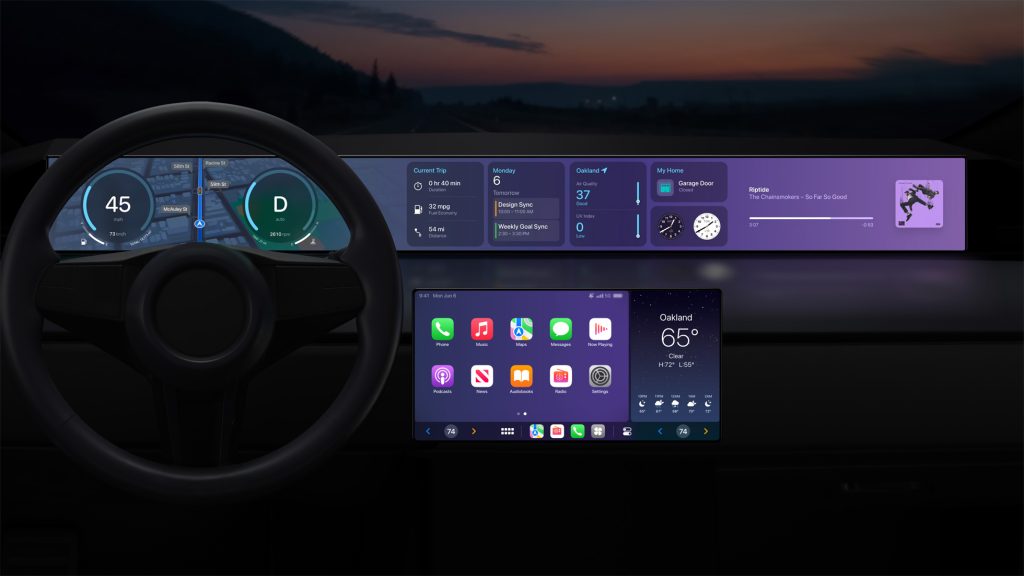How Apple Is Transforming Automotive
Apple has proven itself many times over to be a catalyst for transformation. The Macintosh changed the personal computer user interface fundamentally for people and businesses. The iPhone ushered in the app economy for businesses and a mobile lifestyle for people. At Apple’s annual Worldwide Developers Conference (WWDC), Apple offered a glimpse at how it might transform the automotive industry.
At WWDC, Apple gave attendees a look at a newly imagined driving experience through CarPlay. For context: CarPlay is Apple's standard that allows a driver (or passenger) to connect their iPhones to their cars in order to access their devices while they’re on the road. With CarPlay, a driver can perform basic functions such as making calls, receiving messages, listening to music from their favorite apps, and getting turn-by-turn directions from their preferred wayfinding apps. The car’s bigger infotainment screen, instead of the tiny iPhone screen, becomes the essential hub, because CarPlay displays necessary information there from the iPhone.
Apple demonstrated how CarPlay is evolving into more of an experience. Apple showed how the next generation of CarPlay will more deeply integrate with a car's hardware. This will allow it to display information across multiple screens in a host vehicle. The more immersive experience will make it possible for drivers to adjust climate controls, activate a seat heater, or tune the radio directly through CarPlay without having to leave Apple’s user interface. Through CarPlay, the driver can monitor essential driving data such as current speed, fuel, and battery levels, navigation details, and other essential information in a more unified design.
Apple also said it will offer different themes and layouts to customize the look of a car's instrument cluster. For instance, a driver will have the ability to display details such as speed and fuel details on top of an Apple Maps street-level navigation view. An iPhone-like widget can support apps such as Weather and Apple Music from the car’s dashboard. According to Apple, the interface is adaptable to fit different screen sizes within a given vehicle.

It’s as if Apple were transforming standard-looking infotainment screens into the more immersive and intuitive user interface we get from Apple personal computers.
Apple said it will start to announce compatible vehicles in 2023. Between now and then, one thing is certain: CarPlay will continue to compel automakers to view their cars as large mobile computing devices in addition to being a way for people to travel. Since being introduced in 2014, CarPlay has expanded to be a core feature on more than 80 percent of new cars sold in the United States. As a result, automakers have been challenged to design vehicles with better user interfaces on their infotainment screens. And the popularity of CarPlay has inspired them to more openly collaborate with Apple and Google (which offers a competitor to CarPlay, Android Auto). It’s more difficult for automakers to justify creating proprietary, closed-loop information management systems when drivers demand Apple or Google to manage their information for them.
The big picture: technology and driving continue to converge. For example, beginning with select 2021 car models, you can unlock and start your car with iPhone thanks to CarPlay. Sharing keys with friends or family is easy, too. Car keys will even work for up to five hours after your iPhone battery runs out. Think about that: CarPlay is making it possible for drivers to travel with fewer belongings, which means fewer things to lose and replace (which can be a costly experience for owners of car fobs and keys when they work through their auto dealer).
The uptake of CarPlay is but one of many examples of how evolving technology creates opportunities for businesses to transform themselves and the user experience. We recommend businesses identify a business problem and use tools such as design sprints to test and learn ways to solve those problems with the needs of people at the center. A design sprint consist of four-day test-and-learn process in which a team identifies a business problem with no clear-cut and easy solution and develops a prototype for a solution. For example, a business might ask, “How might we improve customer loyalty with AI technologies such as voice?” We use design sprints as part of our FUEL methodology for unlocking innovation.
Apple has always succeeded by keeping people at the center of all its advances in technology and design. We can help you do that, too. Contact us to learn more.
